#analog magnetic tape
Text

There was a home video tape format called Video 2000 (V2000), that was released in late-1970s and discontinued in late-1980s. It was mostly owned by Philips. These kinds of tapes can literally record video content on both sides in the similar way as audio cassettes.
The format itself, had minor success in Europe, just like what Sony's Betamax (Beta) had its same level of success in the US. However, both of them lost to VHS. But, Video 2000 is obscure and unpopular in North America.
The image is from Wikimedia Commons.
#video 2000#v2000#philips#video tape#magnetic tape#tape media#physical media#old tech#old technology#vintage technology#vintage tech#retro tech#analog media
13 notes
·
View notes
Text
Tumblr like reel-to-reel tape recorders?
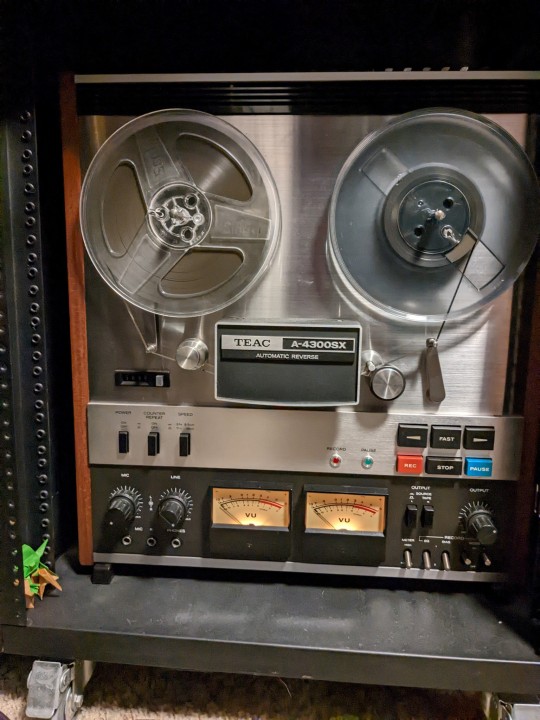
Used this on every track of my forthcoming album, usually on the fundamental elements. Adds a very subtle but pleasing color to the sound; less obvious and much higher fidelity than the cassettes I usually employ.
#music production#studio tools#tape recorder#reeltoreeltapedeck#reeltoreelrecorder#reel-to-reel tape deck#audua tape#magnetic tape#vintage#vintage audio#tape loops#TEAC#vintage gear#studio pics#studio photos#analog audio#analog#producers on tumblr#tape
61 notes
·
View notes
Text
Recording Studio Tech
⚠️ High pitched frequency warning! ⚠️ This frequency may trigger tinnitus.
This is the tedious work behind your favorite music that you rarely get to see. When i was an engineers apprentice, this was the sound that accompanied the start of every morning. In this video a studio apprentice is adjusting the calibration and alignment of the Studer A80 tape machine at Omega Recording Studio. The MRL Calibration Tape plays a 1khz frequency at 250nWb/m. The Weber is the unit of magnetic flux, or in layman’s terms, magnetic strength. It is an important measurement for getting signals on and off of magnetic tape (whether digital or analog). One Weber is much too large a unit to be relevant with tape recorders, so the nanoweber (one billionth of a Weber) is a standard unit of measurement. The recorded level of tape is expressed in nanowebers per meter of tape. Especially in analog recording, the signal level to tape is a critical component in the performance of the tape. Too high a level, and you get distortion and lack of headroom, but with too low a level, your signal-to-noise is compromised. The proper recording level for tape depends a lot on the formulation of the tape and the electrical/magnetic characteristics of the recorder. Recorders are thus aligned using standard reference tapes containing tones at known levels rated in nanowebers per meter. Once the machine is calibrated to a reference, it becomes possible to optimize its levels for the particular formulation of tape desired through another alignment procedure. Recording to tape is just as much an artform as making the music itself.
#studio aesthetic#recoding studio#daddysmusic#analog tape#magnetic tape#studer tape machine#sound engineer#recording engineer#gear geek#studio rat#studio geek#music geek#technology geek
2 notes
·
View notes
Text
Recording Great Guitar Tones on a Budget
Recording Great Guitar Tones on a Budget, we show you some great free guitar software that you can use to get great tones.
In this Recording Great Guitar Tones on a Budget article, we will discuss some ways to get great recorded guitar tones without spending a fortune. The way to get huge guitar tones, with massive amounts of sustain and a sound that will make your guitar stand out from the pack.
Recording Great Guitar Tones on a Budget
For the first part of this series, I’m going to share some links to free…

View On WordPress
#4-Track tape recorder#Ableton Live Lite#amp#amplifier#analog#analogue#Apple#AU#Audacity#Audio Unit#budget#compression#computer#Cubase LE#DAW#Digital#effects#EQ#free software#Garageband#Guitar#Guitar Player 6#Guitar Tone#How to Record Great Rock Guitar Tones on a Budget#Les Paul#MAc#magnetic tape#metal#microphone#MPC Beats
0 notes
Text
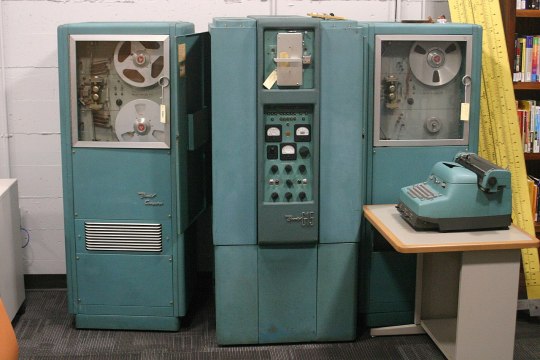
The Bendix G-15 from 1956, the world's first "personal computer." One of these cabinets weighed a literal 1000 lbs. and cost half a million dollars in today's money. Or you could rent it for the equivalent of $17,000 a month.
It was numeric only, you had to "talk" to it via a typewriter, and when you turned it off it 'forgot' everything. It used 'drum memory,' which used the same rust-covered-spinning-magnetic-thing technology all hard drives would continue to use until flash memory became a thing. But in the Bendix it looked something like this (one from a slightly earlier computer):
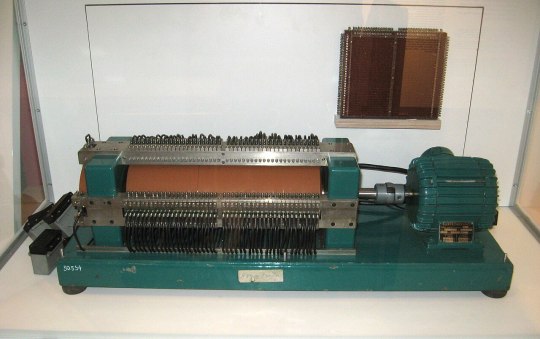
This computer is so old no one seems to have figured out what 'bits' it is. All I know is that drum thing "holds 2,160 words of twenty-nine bits." It can also do basic math problems in 270 microseconds. ...Which sounds fast, but that means it can do 2+2=4 in 27 thousandths of a second. Which is probably exactly how long it took your stupid brain to do that. For slightly more complex math, hiring a human mathematician at this time would be both cheaper and easier than dealing with this computer.
This is a "vacuum tube / diode analog architecture" computer, and it already had some kind of OS that meant you didn't have to know machine code? But that slowed it down even more...?
I have absolutely no idea how analog computers worked, or how anyone used one. There are tape decks on this thing, and it is plugged into a typewriter. Like I get the digital 1 and 0 thing, but I have no concept how you make light bulbs and blobs of germanium do that electronically.
But someone did, and this eventually led to you streaming Now That's What I Call Music! No. 86 on a Samsung phone.
So obviously all of this was a good idea...
827 notes
·
View notes
Text


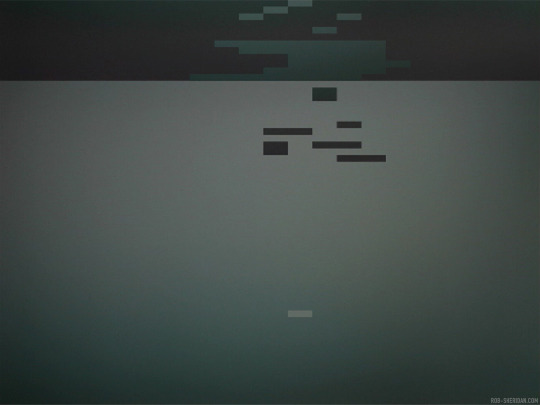



recombinance (2004). Early works with DV data corruption, 20 years ago. As I mentioned in a recent post about NIN’s 2002 And All That Could Have Been DVD, I became during the creation of that film fascinated with the aesthetics of Y2K-era consumer digital video. I was drawn to the uniquely chunky corruption blocks that occurred on lightly-damaged DV tapes, how they were sparse and sometimes gentle in nature.
I filmed some soft gradients, some out-of-focus landscapes and other smooth organic surfaces, and then damaged the tapes (wrinkling the tape, applying magnets/heat, just enough to disrupt the data but still let the tape pass through), seeking the right balance where the harsh digital corruption disrupted and contradicted the soft backdrop while also at times trying to become part of it.
It’s how things felt in the post-millennium migration to all-things-digital, like our old organic analog world was fading out of focus as more of it became rapidly mass-digitized, encoded, and compressed down into tiny efficient grids that more or less replicated what we were at the expense of all the complicated gradients of humanity in between.
Harsh DV data glitches and video interlacing against soft organic textures would form much of the inspiration and methodology of my NIN With Teeth album art in the latter part of 2004 and early 2005.
You can read more about my digital glitch art processes for With Teeth, and download a full tutorial, on my Patreon.
#glitch art#nine inch nails#y2k aesthetic#with teeth#nin#dv glitch#dv tape#digital glitch#data corruption#rob sheridan
146 notes
·
View notes
Note
CRT TV
PRAISE. I can't unpick how much of this is just brute nostalgia but it was so much more tactile, wasn't it? Pressing your hand to that cool curved glass just after you turned one off and feeling the ripple of static electricity under your palm. It was a physical object that worked on these incredibly ingenious but mechanically comprehensible principles, the result of people doing astonishing things with the limited technology available to them. It became a medium unto itself - early console games relied on the blurring, interlacing and upscaling inherent to the projection technology to overcome graphical limitations and make pixels look fluid and organic. Combined with analog broadcast signals and magnetic tape recording it was the perfect locus for art based on incompleteness - distortion, signal loss, static. It looked and sounded the way the world felt, and it's no surprise that kids who never encountered one in real life use digital tools to recreate the experience.
Plus - a big, solid piece of furniture that shot lasers at your face. What's not to like? There's an intimacy there in that shockingly heavy and unwieldy box. When you picked up a 90s CRT you had to hug it to your body, cradling it like a dog. The moral alarmists of the TV era hated this aspect of the experience particularly, but we have always been a species that communes with totems and I feel there was more dignity in the unidrectionality of broadcast television than there is in the sticky free-for-all of the internet. The clunk and whirr of a VHS tape spinning up, badly tracked and slipping off the surface of the screen, the phosphor glow, the whisper of magnetized dust: it felt alive like a body, where a computer feels alive like a toddler's brain.
127 notes
·
View notes
Text
i don’t think that jmart are trapped in the puter. i think it’s just their voices - but not just jonny’s and alex’s voices, but jon’s and martin’s
remember how in mag 65 tessa winters talks about how casette tapes being analogical is a common misconseption and how in actuality they are digital, just an old version of digital? i think that somehow, the tapes we know and love tangeled together with the puters (old digital merging with old digital, making it impossible to update (also, im pretty sure that tapes are the direct predecessor to floppy discs, they’re also both a kind of magnetic storage (it was never about analog vs digital but about magnets after all lmao))) and that’s how norris and chester sound like jmart - their voices are the most common on the tapes after all. i think that tma’s ending will remain sort of open, and that norris and chester are not martin and jon, but merely an echo, a small part of them.
#enjoy my thoughts from january#still stand by this mut so much more has happened lmao#now we do know that there might be more going on with celia being there and jon sending emails and whatnot#tmagp#the magnus protocol#*but not mut#i’ve connected the dots#you didn’t connect shit#i’ve connected them#cringing around
21 notes
·
View notes
Text
People call me grandpa for my analog music collection until the internet goes out or the Bluetooth adapter breaks and then suddenly it's "hey Sol where's the vinyl put on some vinyl please just a crumb of magnetic tape"
80 notes
·
View notes
Text
in magnus archives episode 65 the difference between binary and analog is discussed. the spooky spooky guy that provokes the statement says that existing in binary code cuts his mind, traps his thoughts. we also know that binary or digital recordings of supernatural occurrences get corrupted, as this is the reason jon starts recording statements on magnetic tape (an analog recording method).
not only are the tapes able to record supernatural happenings, they pick up distortions and irregularities caused by supernatural events that the regular human senses might not. think the static that happens when jon uses archivist powers. we also know that analog instant cameras (for example some models of polaroids) are immune to the tampering of the NotThem.
therefore analog technology can be used to record and measure the Fears. my theory is binary recordings fail due to that issue in mag 65 of how the complexities of the mind cannot be broken down into 1’s and 0’s and if the Fears are hell on a human mind’s comprehension then they’re fucking devastating to binary tech. anyway. let me into artifact storage with a bunch of analog tools to measure and record the artifacts during testing. Let Me In
137 notes
·
View notes
Text

I'm not one of those analog purists or anything, but recording on a 4-track, bouncing tracks, making sure you get everything right in one go (I never punch in), pressing actual buttons, waiting for the tape to rewind, etc. is just... more fun than using a DAW. Not to mention the sound. It's not that it's "warmer" - it just sounds more *alive* to me. I guess it's the same reason I'm in love with the VHS look. It's all about the magic of magnetic tape.
103 notes
·
View notes
Text

scientificguitarist - Don't Tell Ray - PT2399-Based Oil Can Delay
DIY oilcan delay kit
"When it comes to delay, we are all aware of the tape, analog, digital, and even magnetic drum style delays like the Echorec. However, there is one design that has been almost lost to time, and that is the oil can delay. Invented by the founder of Tel-Ray, the oil can delay operates by using a spinning magnetic disk with carbonized rubber read and write heads. The disk spins in a can of special oil that helps to keep the rubber heads lubricated and to help prevent the leakage of the magnetically stored data.
In the guitar pedal world, there has been a small resurgence of interest in the oil can delay due to its unique, murky sound. Old Blood Noise Endeavors and Catalinbread both have digital emulations of them, but as far as I could tell, no DIY designs existed. I decided to see what I could do with the ubiquitous PT2399. Over the course of a few months, I spent hours reading and watching everything I could find on them, detailing things like delay time ranges, RPM, methods of degradation, etc. so that I could take them into account as best I could. While I don't claim this circuit to be an exact emulation, it does a great job of getting some of that super old school vibe in a DIY-able circuit. And because it's supposed to mimic a Tel-Ray, I have decided to call it Don't Tell Ray."
cred: scientificguitarist.wixsite.com
19 notes
·
View notes
Text
Lines from Mag 65: Binary that feel different now
Magnetic tape. Everyone thinks it’s analog, but it’s digital. A lower-tech version than what we use now, but people forget that it was used to store computerized data for decades
We’ve tricked ourselves into thinking that computers and people have anything in common? But no matter how good we may program them to be at pretending to think like us, that’s all we’ll ever be. Crossing the line from meat and chemicals into pure digital systems is impossible. And everything else is just sophisticated programming and, and illusion.
“the angles cut me when I try to think,” which marks the start of the bot’s descent into madness
I keep thinking about the idea of uploading your mind into a computer. I said it was impossible. I still think it’s impossible, in the way we want it to be. But I can’t stop wondering what it must be like to try and have thoughts, messy human thoughts, trapped in the rigid digital processes of a computer.
Bonus: While the incident itself seems ultimately inconsequential...
10 notes
·
View notes
Text
they genuinely really gotta invent new forms of magnetic tape based media i want them to replace all the media formats in the world on like. cassettes but fucked up and stupidly designed like they could be triangles or something and but they were better then other storage media. also it's analog
this will make the computer fuckable btw
#jade talks#its like we need more magnetic tapes how about a one of those vcrs but like you could hold it and it'd be your one true love.#she could chew up your tapes if she got mad
9 notes
·
View notes
Text
Kids of the 90s: "CDs are all the rage! Vinyl records are gonna die out!!"
Music / Audio afficionados of 2024: *still enjoying analog music very much, thankyewforasking!*
...
What most people don't realize about digital music is that it is snapshots of the sound, taken at specific intervals. Whatever falls in the gaps of time between those snapshots is forever lost (unless there's an analog recording). It sounds "intact" because, just like motion pictures, each frame or sample is spaced so closely to the next that our brain blends them together.
Vinyl records are analog. They contain the absolute, full, complete vibrational sequences, all of the waves, totally intact, no missing segments or pieces. (Magnetic tapes, such as cassette tapes or VHS tapes, etc, are also considered analog, because it is continuous recording, not segmented sampling.)
4 notes
·
View notes
Text
Greylock Tapes: What’s with the masks?
Throughout the analog horror series Greylock Tapes, masks figure prominently. The Tall Man frequently wears a white mask while wreaking havoc, as seen in blink-and-you’ll-miss-it frames in multiple videos. Another video shows a photograph of a group of black-clad figures wearing white masks.

In the “Awaken Your Subconscious” module in Tape 012, the trainee is shown white masks depicting emotions incongruent with the words written on them. This occurs after the contents of the module are corrupted, as a long-fingered silhouette of the Tall Man creeps closer.

At the climax of the exercise, we see the Tall Man’s face, covered with a mask emblazoned with the word “changed”.
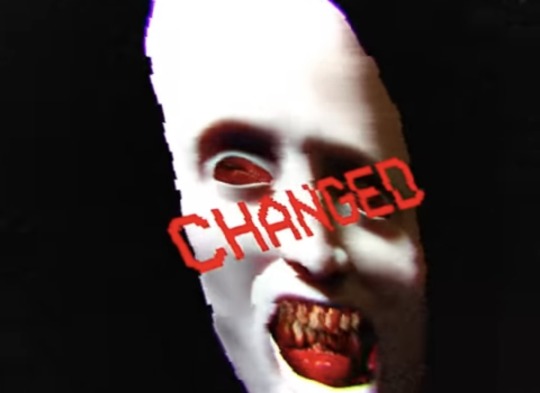
What is the significance of these masks? Who are the masked, black-clad figures? Cultists? Hostile thoughtforms? Some unknown faction? What is their relationship to the Tall Man?
For that matter, who is the Tall Man? An unusually powerful thoughtform? A personification of humanity’s evil shadow, waiting beyond the Black Door in every person’s psyche? An avatar of the entity inhabiting Mount Greylock? Is he a single being, or a group of identical beings? Why is he fond of masks?
One of the reasons why Greylock Tapes is so magnetic is because of the complex worldbuilding. So much is hinted, but so many questions still remain unanswered, including the mystery of the masks and those who wear them.
5 notes
·
View notes